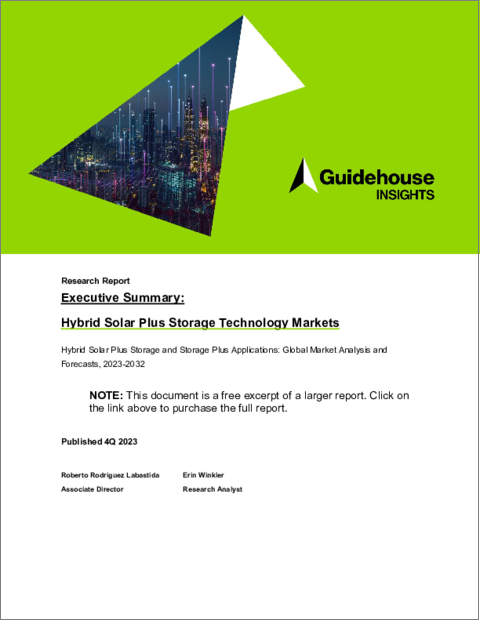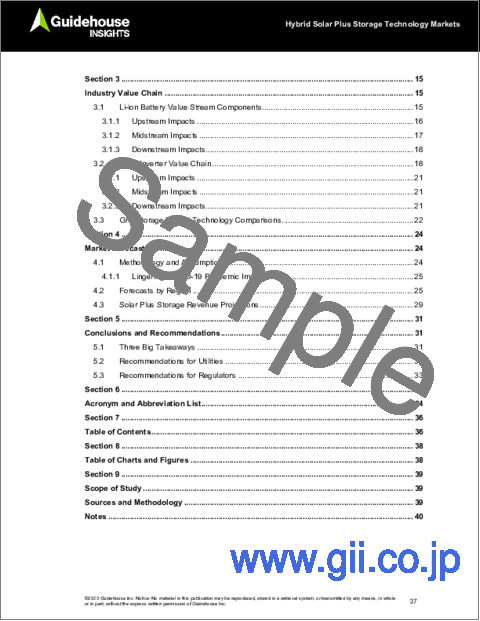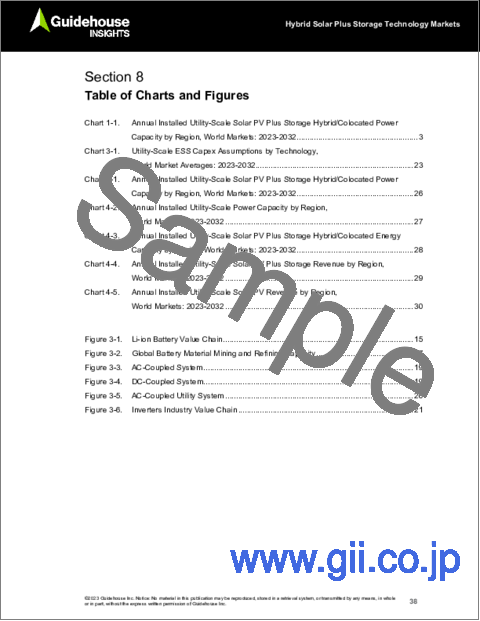|
|
市場調査レポート
商品コード
1397927
ハイブリッド・ソーラープラスストレージ技術の市場 - ハイブリッド・ソーラープラスストレージとストレージプラスアプリケーション:世界市場の分析と予測 (2023年~2032年)Hybrid Solar Plus Storage Technology Markets - Hybrid Solar Plus Storage and Storage Plus Applications: Global Market Analysis and Forecasts, 2023-2032 |
||||||
|
|||||||
| ハイブリッド・ソーラープラスストレージ技術の市場 - ハイブリッド・ソーラープラスストレージとストレージプラスアプリケーション:世界市場の分析と予測 (2023年~2032年) |
|
出版日: 2023年12月20日
発行: Guidehouse Research
ページ情報: 英文 41 Pages; 25 Tables, Charts & Figures
納期: 即納可能
|
全表示
- 概要
- 目次
太陽光発電による断続的な再生可能エネルギー発電技術は、世界の発電量に占める割合が過去最高を記録するまでに急成長し、現在も拡大を続けています。この成長を支えているのは、技術改良やコスト削減、政策支援と転換です。2022年に記録的な規模の再生可能エネルギー発電設備容量が導入されたことで、世界の再生可能エネルギー供給量は約8%増加しました。長期契約、送電網への優先アクセス、資金調達の増加は、断続的な再生可能エネルギー発電技術の導入が今後10年間も急速に拡大し続けることを示唆しています。太陽光発電による電力供給の変動性を考えると、増加する再生可能エネルギーを確実かつコスト効率よく送電網に統合するには、送電網の柔軟性を向上させるソリューションが必要となります。
当レポートの地域別予測には、技術価格も含まれています。すべての予測は2023年から2032年までの10年間を対象としています。これらの予測は、各地域で建設・計画中の新規プロジェクト、COVID-19パンデミックによる長引く混乱、インフレ抑制法 (IRA) の施行、現在の経済困難要因を考慮し、2021年の予測から修正されています。
北米市場は、再生可能エネルギー+ストレージの分野で、現在世界最大の市場であり、少なくとも2032年まではその状態が続くと予測されています。この地域の成長を牽引しているのは、米国におけるソーラープラスストレージ (太陽光発電+蓄電) の新規プロジェクトと、ハイブリッドシステムの成長を促す政策変更です。2023年には、北米では太陽光発電と並行してエネルギー貯蔵システム (ESS) が新たに11,881MW設置され、合計で27,259MWのユーティリティ規模の発電容量が見込まれています。2032年まで、アジア太平洋はソーラーアンドストレージ・システムの新設容量が年間13,488MWとなり、全体では第2位の市場規模を維持すると予想されます。
目次
第1章 エグゼクティブサマリー
第2章 市場の問題
- 促進要因
- ハイブリッド・ソーラープラスストレージの購入契約の価格
- エネルギー法規の方針変更
- 遠隔地におけるマイクログリッド
- 化石燃料発電所の廃止
- 責任ある土地利用
- ユーティリティ計画の課題
- 抑制要因
- 予測
- 市場緩和と物理的抑制
- 市場参加・スケジューリングソフトウェア
- 能力認定
- オファーのパラメーター
- 相互接続
- リソースの計画と配分
- 経済的困難による影響
- ストレージプラスアプリケーション
- 運転抑制と送電輻輳
- エネルギー価格の裁定取引
- 再生可能エネルギーの出力
- 容量市場とリソースの適切性
- 付帯サービス
- 遠隔マイクログリッドと島嶼地域のサポート
第3章 業界のバリューチェーン
- リチウムイオン電池のバリューストリーム・コンポーネント
- 上流工程への影響
- 中流工程への影響
- 下流工程への影響
- 太陽光発電インバーターのバリューチェーン
- 上流工程への影響
- 中流工程への影響
- 下流工程への影響
- グリッドストレージプロジェクト:技術の比較
第4章 市場予測
- 分析手法と前提条件
- COVID-19感染拡大の長引く影響
- 地域別の予測
- ソーラーアンドストレージの収益予測
第5章 結論・提言
- 3つの大きなポイント
- ユーティリティ向け提言
- 規制当局向け提言
第6章 頭字語と略語のリスト
第7章 目次
第8章 図表
第9章 分析範囲、情報源・分析手法、注記
Intermittent renewable energy generation technologies via solar PV have surged to capture a record share of global electricity generation and continue to expand. Technology improvements, cost reductions, and policy support and shifts underpin this growth. Record breaking renewable electricity capacity installations in 2022 have aided in global renewable energy supply increasing by about 8%. Long-term contracts, priority access to the grid, and increased funding suggest that the deployment of intermittent renewable energy generation technologies will continue to expand rapidly in the coming decade. Given the variability of power supply from solar PV, integrating increased levels of renewable energy onto electricity grids reliably and cost-effectively will require solutions that improve grid flexibility.
The forecasts in this Guidehouse Insights study, which are segmented by region include technology pricing. All forecasts cover the 10-year period from 2023 to 2032. These forecasts have been revised from 2021 projections to account for new projects in the regional pipeline, lingering disruptions from the COVID-19 pandemic, the launch of the Inflation Reduction Act (IRA), and current economic hardship factors.
The North American market is currently the largest globally for renewables plus storage and projected to remain so through at least 2032. Leading the region's growth are new solar plus storage projects in the US, and policy changes that encourage growth of hybrid systems. In 2023, North America is expected to see 11,881 MW of new energy storage system (ESS) capacity installed alongside solar PV, and 27,259 MW of total utility-scale power capacity. Through 2032, Asia Pacific is expected to remain the second largest market overall with an annual 13,488 MW of new solar PV plus storage capacity.
Table of Contents
1. Executive Summary
- 1.1 Market Introduction
- 1.2 Market Forecasts
2. Market Issues
- 2.1 Drivers
- 2.1.1 Hybrid Solar Plus Storage Purchase Agreement Prices
- 2.1.2 Policy Changes to Energy Codes
- 2.1.3 Microgrids in Remote Regions
- 2.1.4 Fossil Fuel Power Plant Retirements
- 2.1.5 Responsible Land Use
- 2.1.6 Utility Planning Challenges
- 2.2 Barriers
- 2.2.1 Forecasting
- 2.2.2 Market Mitigation and Physical Withholding
- 2.2.3 Market Participation and Scheduling Software
- 2.2.4 Capacity Accreditation
- 2.2.5 Offer Parameters
- 2.2.6 Interconnection
- 2.2.7 Resource Planning and Distribution
- 2.2.8 Impacts from Economic Hardship
- 2.3 Storage Plus Applications
- 2.3.1 Curtailment and Transmission Congestion
- 2.3.2 Energy Price Arbitrage
- 2.3.3 Renewables Output
- 2.3.4 Capacity Markets and Resource Adequacy
- 2.3.5 Ancillary Services
- 2.3.6 Remote Microgrids and Support for Island Regions
3. Industry Value Chain
- 3.1 Li-ion Battery Value Stream Components
- 3.1.1 Upstream Impacts
- 3.1.2 Midstream Impacts
- 3.1.3 Downstream Impacts
- 3.2 Solar Inverter Value Chain
- 3.2.1 Upstream Impacts
- 3.2.2 Midstream Impacts
- 3.2.3 Downstream Impacts
- 3.3 Grid Storage Project Technology Comparisons
4. Market Forecasts
- 4.1 Methodology and Assumptions
- 4.1.1 Lingering COVID-19 Pandemic Impacts
- 4.2 Forecasts by Region
- 4.3 Solar Plus Storage Revenue Projections
5. Conclusions and Recommendations
- 5.1 Three Big Takeaways
- 5.2 Recommendations for Utilities
- 5.3 Recommendations for Regulators





